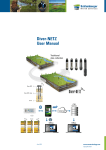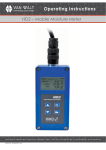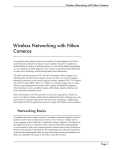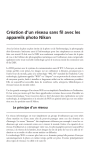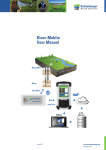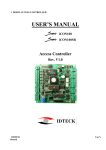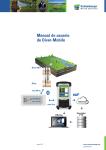Download Diver Netz Operating Instructions
Transcript
Operating Instructions Diver-NETZ Van Walt Ltd | Prestwick Lane | Grayswood | Haslemere | Surrey | GU27 2DU | Tel. 01428 661 660 | Fax. 01428 656 808 | www.vanwalt.com MA166V1_21/08/2012_TD Operating Instructions Diver-NETZ CE COMPLIANCE STATEMENT (EUROPE) This device is in conformity with the EMC directive and low-voltage directive. 1. Introduction With Diver-NETZ technology, monitoring ground and surface water becomes easier, faster and more reliable. Diver-NETZ is a wireless method for reading out Diver data, Baro data and programming Divers. A physical connection between read-out equipment and Diver is no longer necessary. With Diver-NETZ it is no longer necessary to find the monitoring well, the monitoring well finds you. The monitoring well (with Diver-DXT installed) periodically tries to connect to an available Diver-Gate(M) in radio range. This Diver-Gate(M) is connected to the field computer (smart-phone or PDA) using Bluetooth. As soon as you have read out the field data with the field computer, you can transfer the data to a FTP server or keep it in the local queue. All data will be stored in the database of the field computer. Programs like Diver-Office and Diver-Office Premium are used to interpret, validate or visualize the Diver-data. Any existing network of Divers can be fitted with the Diver-NETZ technology quickly and easily. 1.2 Functional description The Diver-DXT allows for a wireless remote access to the data stored in the Diver. The enclosure which contains the radio PCB and battery remains on ground surface, the Diver is placed below ground level inside a well. Both units are connected using a two-wire cable, which acts both as a communication link and as a mechanical link to place the Diver into the well at a known distance. The Diver is placed into a well, connected by a cable to the Diver-DXT (radio) which remains on the surface (well cover) or just below the surface (street pot). Once configured, the Diver will autonomously collect and store temperature and pressure data into its non-volatile memory at a certain sampling rate (customer setting). The Diver is equipped with its own power supply (battery). The Diver has an optical interface and therefore there is no electrical connection to the rest of the system (Diver-DXT and cable). Once the operator wants to retrieve data from the Diver (or any other communication like configuration of sampling rate or other settings), a radio link between a second radio (Diver-Gate(M)) and the Diver-DXT can be established in a “drive-by” or “walk-by” manner. The radio link between Diver-Gate(M) is realized according to the IEEE standard 802.15.4: Wake-up Session When the Diver-Gate(M) communicates with the Diver-DXT, it first starts with a wake-up session to awake all the Diver-DXTs around and get a list of them. It sends broadcast wake-up frames permanently (each 7ms) during 29s. Within these frames a countdown is included related to the remaining wake-up session duration. In Van Walt Ltd | Prestwick Lane | Grayswood | Haslemere | Surrey | GU27 2DU | Tel. 01428 661 660 | Fax. 01428 656 808 | www.vanwalt.com Operating Instructions Diver-NETZ the meantime, each DXT is in slow cyclic wake-up. It is in sleep mode most of the time, and awakes periodically (each 14s, asynchronously) during 12ms to listen to the RF channel. If nothing is detected, it returns to sleep mode. If it detects a valid frame, it answers back its identifier, analyzes the countdown and returns to sleep mode until the end of the wake-up session. At the end of the Wake-up session, the Diver-Gate(M) has the list of available Diver-DXTs. Communication session After wake-up session, each Diver-DXT turns into fast cyclic wake-up: it is the same as slow cyclic wake-up, with a period of 1s instead of 14s. This is the Communication session, which is two minutes by default. During this period, the Diver-Gate(M) can communicate with each Diver-DXT available. To initiate the communication with one DXT, the Diver-Gate(M) starts a dedicated wake-up session and waits for the answer of the addressed DXT. Then the communication can occur: this is the Communication slot. At the end of the communication, the Diver-Gate(M) can send the order to the Diver-DXT to go back to fast cyclic wake-up. Otherwise, the Diver-DXT automatically switches back to slow cyclic wake-up after time-out. At the end of the Communication session, the remaining awake Diver-DXTs automatically switch back to slow cyclic wake-up. 2. Diver-NETZ components The components of the Diver-NETZ system are: • Diver datalogger • Diver-DXT • Cable with cable connector, strain relief and cable length adjustment. You specify the maximal length of each cable in your order (the cables can be adjusted to the correct length in the field) • Diver-Gate(M) interface to the field computer • Diver-Mobile or Diver-Pocket for Windows Mobile Additional components: • plastic protective cap, available in 2 models: • for 1 Diver-DXT • for up to 4 Diver-DXT • drilling stencil DIF 05.010; available in 2 models: • 1 × 23 mm • 4 × 23 mm • cable adaptors for fitting / shortening the cable. 2.1 How to store and handle equipment before installation Before installation of the equipment the instrumentation should be stored in a safe place. However it is important to know what the effect of storage means for the instrument. The Diver-DXT has a build in battery which cannot be switched off. The instrument is always active and consumes energy from the battery. The total battery capacity will reduce approx. 4% per year in this condition. Another important issue is the storage temperature. If the instrument is stored for a long time (months) it is best to store the instrument in a dark place at room temperature and low humidity. The instrument is tested according to ASTM D 4169-09 DC 2 (transport simulation test). Make sure that the instrument is unpacked just before installing the instrument in the field. The instrument is also tested according to MIL-STD-810 and ASTM D 3332 (shock and vibration tests). This test simulates the mechanical shock and vibration during installation of the equipment (Diver-DXT). Although the equipment can handle these conditions is should be clear to avoid any shock and vibration were possible. The Diver-DXT has sensors build in which need to be handled with care. Van Walt Ltd | Prestwick Lane | Grayswood | Haslemere | Surrey | GU27 2DU | Tel. 01428 661 660 | Fax. 01428 656 808 | www.vanwalt.com Operating Instructions Diver-NETZ 2.2 What you need to know about radios before installing the equipment The technology used on the radios of the Diver-DXT and Diver-Gate(M) makes use of the ISM (Industrial, Scientific and Medical) band. Specifically, 2.4 GHz frequency is used. This band is unlicensed, which means, that the frequencies are open for public use and require no registration or payment for usage of the frequency. In order to be in line with the regulations, the output power of the devices is regulated. Therefore, this may cause that the range of the radio device to be limited. Typically, the range of the device used on the Diver-DXT is about 500 m (1.300 ft) L.o.S. (Line of Sign). Certain characteristics inherent to the environment, where the system is deployed, may affect the range of the radio system. This could be -but not limited-: big mass of water, trees, forest, metal caps for borehole protection, atmospheric conditions, ambient frequency, noise, and general conditions of the terrain. And when referring to the antenna: positioning, gain and antenna tuning, etc may affect the range of the radio system. For the best performance of the radio devices, it is advised to place the Diver-DXT in an area where is possible to “see” the device without obstacles in between. The antenna of the Diver-DXT must “see” the antenna of the Diver-Gate(M). This is not mandatory but improves the performance of the system. If that condition is not accomplished, the performance of the system could be drastically reduced. Depending what obstacles are in between, this may impact the propagation of the signal. 2.3 What you need to know about radio performance Limitations wave propagation. Certain environmental conditions may affect the performance of radio propagation of the Diver-Netz. The device is designed mostly to be deployed in outdoor environments. In the field, few (or a combination of) environmental conditions might be present during short or long period of time. This phenomenon’s such as (but not limit to): rain, snow, fog, big mass of water, buildings in urban areas, aurora boreal, an agglomeration of trees (forest), mountains or other obstacles on the terrain might affect the performance of the radio waves propagation. The environmental conditions mentioned above might introduce undesirable effects such as destructive interferences, scattering, and reflexions, which reduce the performance of the system. We therefore recommend a site assessment in order to plan and optimize the deployment of the devices. 2.4 What you need to know about Bluetooth Bluetooth is a simple two way wireless radio technology that allows different devices to connect between each other without the use of cables or infrared. This technology is robust, low power and low cost. The short range radio link provides connectivity between different devices, such as mobile phones, PDA’s, mobile PC’s and other electronics devices. It is designed to be used in small range communication and it allows voice and data communication.. It operates at 2.4 GHz radio spectrum. Each class provides a different power output. Therefore they have a different communication range. This is certified in three different type of standards class 1 (100m), class 2 (10m), class 3 (1 meter). The Diver-Gate(M) has a class 2 (10m) Bluetooth module. 2.5 System requirements for the field computer • Windows Mobile Version 6.1 professional or higher • A minimum of 128 MB of RAM memory • A minimum of 4 GB of Flash memory 2.6 Before you go into the field Ensure that Diver-Mobile and Diver-Pocket is installed on your field PC. Make sure that the Diver-Gate(M) is paired to you field PC and that the battery is fully charged. 2.7 Installation of Diver-Gate(M) The Diver-Gate(M) is normally used in combination with a field PC. The Diver-Gate(M) is the link between the Diver-DXT radio and the field PC (either mobile phone or PDA). Both links are radio links. The radio link between the Diver-Gate(M) and the field PC is based on a Bluetooth link. To install this Bluetooth link the following steps need to be done: • Attach the pairing dongle to the Diver-Gate(M) and turn on Diver-Gate(M). • Turn on the Bluetooth of the field PC and activate the discovery mode. • Select Bluetooth device (name is SWSGW_1414xxxxxxxx). • Enter PIN-code “1234”. • Activate “Serial port”. • Disconnect the dongle (Diver-Gate(M) will automatically restart) • After approx. 30 seconds the Bluetooth led will turn on to indicate Bluetooth connection. Van Walt Ltd | Prestwick Lane | Grayswood | Haslemere | Surrey | GU27 2DU | Tel. 01428 661 660 | Fax. 01428 656 808 | www.vanwalt.com Operating Instructions Diver-NETZ 2.8 Installing Diver-Mobile: In order for the operator to be able to collect and send data to a FTP server, it is necessary to install a mobile application. This software is called Diver-Mobile. The procedure necessary to follow to install the Diver-Mobile is described as follows (see also M2-1111500006E Diver-Mobile installation instructions): • Copying both CAB files (database and Diver-Mobile application) on the mobile device. • Install the database application on the mobile device by double clicking the CAB file (using Explorer) and follow the instructions • Install the Diver-Mobile application on the mobile device by double clicking the CAB file (using Explorer) and follow the instructions • Make the needed changes in the config file (see below) • Diver Mobile is ready for use. Config file After installation of the Diver-Mobile application a default config file is created (Diver-Mobile.exe.config). This file contains the following setting: • FTP server setting • Encryption key settings (ask manufacturer if you need to changes these settings) • Network ID settings (ask manufacturer if you need to changes these settings) It is important to change the FTP settings if you want to use the option to sent data from the field computer to the FTP server. Change the following settings in the config file: <!--Ftp settings.--> <add key=”FtpHostName” value=”84.244.177.163”/> <add key=”FtpPortNumber” value=”21”/> <add key=”FtpRemoteDirectory” value=”/test”/> <add key=”FtpUserName” value=”user”/> <add key=”FtpPassword” value=”Welcome01”/> IP address of the FTP server Port number of the FTP server Folder to place the data files Login Username Login Password Van Walt Ltd | Prestwick Lane | Grayswood | Haslemere | Surrey | GU27 2DU | Tel. 01428 661 660 | Fax. 01428 656 808 | www.vanwalt.com Operating Instructions Diver-NETZ 2.9 Installing Diver-DXT-Start Diver-Mobile is not suitable to read or change settings of the Baro logger in the Diver-DXT. To be able to start the Baro logger of the Diver-DXT a separate program is made. The program is simple and is based on DiverMobile. To install Diver-DXT-Start, follow the next procedure: • Copying the CAB files (Diver-DXT-Start application) on the mobile device. • Install the Diver-DXT-Start application on the mobile device by double clicking the CAB file (using Explorer) and follow the instructions • Make the needed changes in the config file (see below) • Diver Mobile is ready for use. The baro logging will start at the next first full hour. The sample interval is 1 hour and the registration method is equal to the fixed sample mode of the Diver. The maximum number of records that can be stored in the internal memory of the Diver-DXT is 24000. This is 1000 days of recording (approximate 2.7 years). 2.10 Using Diver-Mobile In this section we assume that pairing of the Diver-Gate(M) with the field computer is done. Before using the Diver-Mobile application there should be a Bluetooth connection between the Diver-Gate(M) and the field computer. Take the following steps to establish the Bluetooth connection: • Make sure the field computer is not completely shut down, • Turn on the Diver-Gate(M), • After 20 seconds the status led will blink and also the Bluetooth led will light up periodically, • After 10 to 30 seconds the Bluetooth led will blink irregular (looks almost continuous on), • Bluetooth connection is made and Diver-Mobile can be started. Start Diver-Mobile from the start menu or using the shortcut (if created). First the splash screen will appear (with the software version number). When the Diver-Gate(M) is detected the second screen will scan for devices (default 30 seconds). During this time the number of devices will be updated to inform the user how many devices are found. It would be nice to place a new screen shot with the last version of Diver-Mobile (2.3.0.0), and to update other screens. The third screen will collect the information of the scanned devices (including the location codes from the Diver which will be used to indicate the location). This can take a few seconds. The fourth screen shows the location codes of the scanned devices divided in two categories. The first (top) category indicates devices which are found for the first time that day. These locations are checked by default (indication to read the data of these devices). The second category (bottom) indicates the devices from which the data was already been read today. These locations are unchecked by default. The user can change the check boxes if needed, but this has to be done within 10 seconds, otherwise the system will automatically continue reading the data of the checked devices. Van Walt Ltd | Prestwick Lane | Grayswood | Haslemere | Surrey | GU27 2DU | Tel. 01428 661 660 | Fax. 01428 656 808 | www.vanwalt.com Operating Instructions Diver-NETZ The next screen gives the information about the status of reading the devices. With the “Skip” button it is possible to skip the reading to the next logger. When all the reading is done the information can be send to the FTP-server by pressing the “FTP” button. The data files (*.dat files) can be imported by Diver-Office. It is also possible to copy/move the *.dat files from the queue folder in the mobile device to your computer. Quitting the application is done by the “Quit” button. If a location was not scanned the process can be repeated using the “ReScan” button. The scanned locations are reorganized in the two groups again. This will help the user to read only the new locations for that day. 2.11 Using Diver-DXT-Start In this section we assume that pairing of the Diver-Gate(M) with the field computer is done. Before using the Diver-Mobile application there should be a Bluetooth connection between the Diver-Gate(M) and the field computer. See previous paragraph. Start Diver-DXT-Start from the start menu or using the shortcut (if created). First the splash screen will appear (with the software version number). When the Diver-Gate(M) is detected the second screen will scan for devices (default 30 seconds). During this time the number of devices will be updated to inform the user how many devices are found. The third screen will collect the information of the scanned devices (including the location codes from the Diver which will be used to indicate the location). This can take a few seconds. The fourth screen shows the location codes of the scanned devices divided in two categories. The first (top) category indicates devices which are not started yet (status is “STOPPED”). The second category (bottom) indicates the devices which are already started (status is “STARTED”). All the locations, from both groups, are unchecked by default. The user can select the location (by check-boxes) to indicate which Baro logger must be started. Pressing the “Continue” button will start the Baro logger from the checked devices. Van Walt Ltd | Prestwick Lane | Grayswood | Haslemere | Surrey | GU27 2DU | Tel. 01428 661 660 | Fax. 01428 656 808 | www.vanwalt.com Operating Instructions Diver-NETZ 3. Installation of the Diver-DXT The Diver-DXT is a radio module with a build in datalogger for barometric pressures. Together with a built in battery the Diver-DXT will operate independent of the equipment connected. However the system will only be functional when a DDC (cable) and Diver are connected. The complete equipment for the well is: • The Diver-DXT (which is placed on top of the well or outside the well) • An electrical cable (DDC) to connect the Diver to the radio (cable length up to 300meter). • Any Mini-Diver, Micro-Diver, Cera-Diver or CTD-Diver. 3.1 Adjusting the cable length It is important to determine the proper cable length for the Diver for the following reasons: • Cable length too short: the Diver is located above the water level. This doesn’t harm the Diver, but the Diver will not record water levels anymore; • Cable length too long: - the Diver can get a too high pressure from the water column on top of the Diver. This can harm the Diver and the Diver will not record water levels anymore; - the Diver can be on the bottom of the well and this can affect the reliability of the Diver data. It is important to know the highest and the lowest expected water level from top of casing (TOC). The difference between the highest and lowest water level is important to define the pressure range of the Diver. The lowest water level from TOC is the minimal cable length. If the Diver-DXT is not placed at top of casing (TOC) level but at another position, it is important to reserve some extra cable length. Variations in the cable length will introduce variations in the Diver readings. Whatever fixation of the cable is used – make sure that it can be easily removed and reinstalled at exactly the same position to avoid “steps” in the recorded Diver data. Van Walt Ltd | Prestwick Lane | Grayswood | Haslemere | Surrey | GU27 2DU | Tel. 01428 661 660 | Fax. 01428 656 808 | www.vanwalt.com Operating Instructions Diver-NETZ Diver-DXT 3.2 Installation in street pot (below ground level) Street pots are often used in urban environment. Most of these street pots are made of synthetic material which allow the use of radios (such as the Diver-DXT). Metal street pots,however, are not suitable for use in combination with the Diver-DXT. The Diver-DXT can only be used when the metal street pot is modified with an external antenna. It is important to provide enough space for the Diver-DXT in the street pot. The space above the top of casing to the bottom of the cover needs a minimum distance of 30 mm. For radio performance it is important to have the Diver-DXT placed as closely as possible to the cover of the street pot. The radio performance will decrease when the distance below ground level is increased. The street pot with (lockable) cover will secure the installation against vandalism. Instrumentation is not visible when the cover is closed. When the Diver-DXT is prepared (cable with correct length and Diver attached) the next actions are needed: • Take manual water level measurement from TOC (top of casing) before the Diver- DXT with Diver is lowered in the well. • Measure and read down the length of the membrane of the Diver to TOC (see figure in “adjusting the cable length” paragraph). • Place the Diver-DXT (with cable and connected Diver) in the well. Van Walt Ltd | Prestwick Lane | Grayswood | Haslemere | Surrey | GU27 2DU | Tel. 01428 661 660 | Fax. 01428 656 808 | www.vanwalt.com Operating Instructions Diver-NETZ 3.3 Installation in wells above ground level Most wells are wells with a TOC (top of casing) above ground level. These wells are often protected by a large protective cover around the wells. Some of these protective covers are made of metal while others are made of a synthetic material. Because the Diver-DXT cannot be used inside a metal enclosing an alternative installation is needed. 3.4 Installation in synthetic protective cover The installation of Diver-DXT in this condition is similar to the installation in a street pot. The Diver-DXT can be placed on top of the well tube and if the location has more than one well it is possible to use more Diver-DXTs. There is no interference between the Diver- DXTs. The protective cover and lockable cap/cover will secure the installation against vandalism. Instrumentation is not visible when the cap is closed. When the Diver-DXT is prepared (cable with correct length and attached Diver) the next actions are needed: • Take manual water level measurement from TOC (top of casing) before the Diver- DXT with Diver is lowered in the well. • Measure the position of the membrane of the Diver to TOC. • Place the Diver-DXT (with cable and connected Diver) in the well. 3.5 Installation in metal protective cover The installation of Diver-DXT in a metal protective cover needs some special actions. The Diver-DXT cannot be placed inside the metal enclosing because of the shielding of radio signals. Therefore the Diver-DXT has to be place outside the metal protective cover. This can be done by drilling holes in the cap and placing the Diver-DXT on top of the cover. It is also possible to place more than one Diver-DXT on top of the cover. A drilling stencil available. An extra robust protection cover is available to protect the Diver-DXT against vandalism. is When the Diver-DXT is prepared (cable with correct length and attached Diver) the next actions are needed: • Take manual water level measurement from TOC (top of casing) before the Diver- DXT with Diver is lowered in the well. • Measure the position of the membrane of the Diver to TOC. • Place the Diver-DXT (with cable and connected Diver) in the well. 3.6 Diver-DXT with build-in barometric sensor and datalogger The Diver-DXT has a build in datalogger for the barometric pressure and ambient temperature. The sensor is located under the top part of the Diver-DXT (see figure below). This sensor should be in open contact with the air pressure! Maintenance is needed to keep the area around the location of the sensor clean. Mud, moisture or water could affect the accuracy of the sensor. Van Walt Ltd | Prestwick Lane | Grayswood | Haslemere | Surrey | GU27 2DU | Tel. 01428 661 660 | Fax. 01428 656 808 | www.vanwalt.com Operating Instructions Diver-NETZ 3.7 Diver-DXT in flooding conditions The Diver-DXT is not meant to be used under water. The radio performance will decrease when the unit is covered or surrounded by water. However sometimes it is difficult to avoid flooding conditions. Therefore the Diver-DXT is developed to withstand this situation for a limited time (maximum one meter under water for two days, see specifications). 4. Troubleshooting No Bluetooth connection? • If the Bluetooth led doesn’t blink at all (even not for a short period) the pairing needs to be done before a connection can be made. Follow the Bluetooth Pairing procedure. • If the Bluetooth led does blink but will not go into almost continuous on mode (indicating the Bluetooth connection), the pairing is done with another device. The pairing needs to be done again with the new field computer before a connection can be made. Follow the Bluetooth Pairing procedure. • If the Bluetooth led indicates a Bluetooth connection but the application can’t find the Diver-Gate(M). It could be possible that the serial port check box in the Bluetooth settings is not set. Check this box (enable serial port) and try again. Software hangs? • Go to task manager and shut down the Diver-Mobile application. • Give your field device a soft reset. How to do this is described in the user manual of the field device. No connection with the Diver-DXTs? If you have no connection after 30 seconds, you can try moving closer to the Diver. Try to make contact again. Try this a few times from different locations. If there is still no connection, the radio may be faulty: • Check if the Radio led (Diver-Gate(M)) is blinking during scanning and check if the Radio led is continuous on during data transfer. If not, the problem could be the Diver-Gate(M). • Check the cable; it may be damaged. If this is the case, the cable must be returned to the supplier. • Check the Diver. Try the cable with a different Diver. If there is still no connection, then the cable is faulty. If there is a connection when a different Diver is used, then the original Diver is faulty. Van Walt Ltd | Prestwick Lane | Grayswood | Haslemere | Surrey | GU27 2DU | Tel. 01428 661 660 | Fax. 01428 656 808 | www.vanwalt.com













